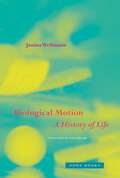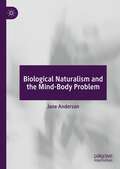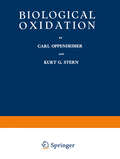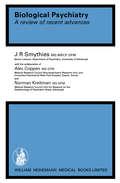- Table View
- List View
Biological Monitoring of Exposure and the Response at the Subcellular Level to Toxic Substances: Proceedings of the European Society of Toxicology Meeting held in Munich, September 4–7, 1988 (Archives of Toxicology #13)
by Philip L. Chambers Claire M. Chambers Helmut GreimThis supplement contains the papers submitted at EUROTOX 88, the joint Congress of the European Society of Toxicology and the Federation of the European Societies of Toxicology. The theme was one of monitoring and examining the effects of toxic substances in the biological response at the subcellular level. Mechanisms of metal carcinogenicity are discussed as well as the biomonitoring of chemical exposure. Reports are provided on the role of individual differences in man and the effect of risk assessment. Papers appear dealing with the genetic control of drug metabolizing enzymes. The role of metabolism in organic specific toxicity is discussed. Information is included on the toxicological impact of chemicals interfering with the endocrine system as well as on the effects of toxicants on the immune system. Presentations deal with the current status of risk assessment in environmental toxicology.
Biological Monitoring of Toxic Metals (Rochester Series on Environmental Toxicity)
by Thomas W. Clarkson Lars Friberg Gunnar F. Nordberg Polly R. SagerThis document is the result of a conference on "Biological Monitoring of Metals" held in Rochester, June 2-6, 1986, organized jointly by the Environmental Health Sciences Center of the School of Medicine and Dentistry of the University of Rochester, NY, and the Scientific Committee on the Toxicology of Metals within the International Commission on Occupational Health (ICOH) at the Karolinska Institute and the National (Swedish) Institute of Environmental Medicine and the University of Umea, Sweden. The aim of the Conference was to define and evaluate the scientific basis for the biological monitoring of metals. The conference was co-sponsored by the World Health Organization through its International Program on Chemical Safety and received substantial encouragement and support from the Swedish Work Environmental Fund and the United States Environmental Protection Agency. This was the second conference organized jointly by the Scientific Committee on the Toxicology of Metals and The Toxicology Division of the University of Rochester. The previous joint conference was held in 1982 on the Reproductive and Developmental Toxicity of Metals. In addition, conferences have been organized by each group (see Appendices A and B). Several of these conferences are specially relevant to the topic of the current conference. These include the joint conference mentioned above and the conferences on dose-effect and dose-response relationship held in Tokyo in 1974 and on accumulation of metals held in Buenos Aires in 1972.
Biological Motion: A History of Life
by Janina WellmannA captivating exploration of the changing definitions of life in biologyBiological Motion studies the foundational relationship between motion and life. To answer the question, &“What is Life?,&” prize-winning historian of science Janina Wellmann engages in a transdisciplinary investigation of motion as the most profound definition of living existence.For decades, information and structure have dominated the historiography of the life sciences with its prevailing focus on DNA structure and function. Now more than ever, motion is a crucial theme of basic biological research. Tracing motion from Aristotle&’s animal soul to molecular motors, and from medical soft robotics to mathematical analysis, Wellmann locates biological motion at the intersection of knowledge domains and scientific and cultural practices. She offers signposts to mark the sites where researchers, technologies, ideas, and practices opened up new paths in the constitution of the phenomenon of motion. An ambitious rethinking of the life sciences, Biological Motion uncovers the secret life of movement and offers a new account of what it means to be alive.
Biological Motion: A History of Life
by Janina WellmannA captivating exploration of the changing definitions of life in biologyBiological Motion studies the foundational relationship between motion and life. To answer the question, &“What is Life?,&” prize-winning historian of science Janina Wellmann engages in a transdisciplinary investigation of motion as the most profound definition of living existence.For decades, information and structure have dominated the historiography of the life sciences with its prevailing focus on DNA structure and function. Now more than ever, motion is a crucial theme of basic biological research. Tracing motion from Aristotle&’s animal soul to molecular motors, and from medical soft robotics to mathematical analysis, Wellmann locates biological motion at the intersection of knowledge domains and scientific and cultural practices. She offers signposts to mark the sites where researchers, technologies, ideas, and practices opened up new paths in the constitution of the phenomenon of motion. An ambitious rethinking of the life sciences, Biological Motion uncovers the secret life of movement and offers a new account of what it means to be alive.
Biological Nanostructures and Applications of Nanostructures in Biology: Electrical, Mechanical, and Optical Properties (Bioelectric Engineering #Vol. 2)
by Mitra Dutta Michael A. StroscioBiological Nanostructures and Applications of Nanostructures in Biology: Electrical, Mechanical, and Optical Properties contains reviews and discussions of contemporary and relevant topics dealing with the interface between the science and technology of nanostructures and the science of biology. Moreover, this book supplements these past groundbreaking discoveries with discussions of promising new avenues of research that reveal the enormous potential of emerging approaches in nanobiotechnology. The topics include: - Biomedical applications of semiconductor quantum dots, - Integrating and tagging biological structures with nanoscale quantum dots, - Applications of carbon nanotubes in bioengineering, - Nanophysical properties of living cells, - Bridging natural nanotubes with fabricated nanotubes, - Bioinspired approaches to building nanoscale devices and systems, - Hairpin formation in polynucleotides. This state-of-the-art survey of key developments in nanotechnology - as they apply to bioengineering and biology - is essential reading for all academics, biomedical engineers, medical physicists, and industry professionals wishing to take advantage of the latest developments and highly-promising discoveries in nanoscience underlying applications in bioengineering and biology.
Biological Naturalism and the Mind-Body Problem
by Jane AndersonThis book offers a new theoretical framework within which to understand “the mind-body problem”. The crux of this problem is phenomenal experience, which Thomas Nagel famously described as “what it is like” to be a certain living creature. David Chalmers refers to the problem of “what-it-is-like” as “the hard problem” of consciousness and claims that this problem is so “hard” that investigators have either just ignored the issue completely, investigated a similar (but distinct) problem, or claimed that there is literally nothing to investigate – that phenomenal experience is illusory. This book contends that phenomenal experience is both very real and very important. Two specific “biological naturalist” views are considered in depth. One of these two views, in particular, seems to be free from problems; adopting something along the lines of this view might finally allow us to make sense of the mind-body problem.An essential read for anyone who believes that no satisfactory solution to “the mind-body problem” has yet been discovered.
Biological Networks in Human Health and Disease
by Romana IshratThis book presents methods and tools of network biology and bioinformatics for understanding the disease dynamics and identification of drug targets. The initial section of chapters introduce the theoretical aspects followed by the different applications for construction and analysis of biological networks, methods for identifying crucial nodes in networks, and network dynamics. The book covers the latest advances in the network medicine, exploring the different types of biological networks, and their applications. It further reviews the role of R language in the network-based approaches that help in understanding biological systems and identifying biological functions. Towards the end, the book explores the recent developments and applications in machine learning and its potential for advancing network biology. Finally, the book elucidates a comprehensive yet a representative description of challenges associated with the understanding of disease dynamics using network biology. Given its scope, the book is intended for researchers and advanced postgraduate students of bioinformatics, computational biology, and medical sciences.
Biological Neural Networks: Hierarchical Concept Of Brain Function
by Konstantin V. BaevThis book is devoted to a novel conceptual theoretical framework of neuro science and is an attempt to show that we can postulate a very small number of assumptions and utilize their heuristics to explain a very large spectrum of brain phenomena. The major assumption made in this book is that inborn and acquired neural automatisms are generated according to the same func tional principles. Accordingly, the principles that have been revealed experi mentally to govern inborn motor automatisms, such as locomotion and scratching, are used to elucidate the nature of acquired or learned automat isms. This approach allowed me to apply the language of control theory to describe functions of biological neural networks. You, the reader, can judge the logic of the conclusions regarding brain phenomena that the book derives from these assumptions. If you find the argument flawless, one can call it common sense and consider that to be the best praise for a chain of logical conclusions. For the sake of clarity, I have attempted to make this monograph as readable as possible. Special attention has been given to describing some of the concepts of optimal control theory in such a way that it will be under standable to a biologist or physician. I have also included plenty of illustra tive examples and references designed to demonstrate the appropriateness and applicability of these conceptual theoretical notions for the neurosciences.
Biological Odour Treatment (SpringerBriefs in Environmental Science)
by Pratima BajpaiShowcasing the very latest technologies for neutralising the unpleasant—and sometimes dangerous—odours from industrial and waste management processes, this Springer Brief in Environmental Sciences covers physical, chemical and biological methods. The volume includes modern biotechnological approaches now making it cost-effective to tackle malodorous chemicals at very small concentrations. The book reflects the fact that odour affects us in several ways, which range from compromising our quality of life to causing respiratory and other unpleasant conditions and from depressing property values to severe health problems caused by the toxic stimulants of odours.Innumerable industrial processes release malodourous and harmful vapours. The human sense of smell can detect some noxious chemicals, such as the sulphurous by-products of paper manufacturing, at concentrations of one part per billion. This e-book shows what has been achieved in combating offensive and harmful odours. While conventional air pollution control technologies can treat a wide variety of pollutants at higher concentrations, the chapters cover the more refined biological methods used to deal with odours and volatile organic compounds in low concentrations. These include bio scrubbers and bio trickling filters. Standing alongside its detailed discussion of the health impacts of total reduced sulphur compounds, and the composition of paper pulp industry emissions, this publication offers comprehensive and in-depth treatment of some of the most potent anti-odour technologies yet devised.
Biological Order and Brain Organization: Selected Works of W.R.Hess
by K. Akert M. Bornstein V. Bucher R. M. Hess S. Hess P. Levin G. P. MichelThe centennial of his birthday (17 March 1881) prompted the publi cation of the Selected Works of Walter Rudolf Hess. Although English translation of several of his monographs have appeared, none of his orig inal papers has ever been published in the English language. During his sci entific career, Hess made pioneering contributions in the field of hemo dynamics, pyhsiological optics, oculomotor diagnostics, regulation of cir culation, respiration and temperature, and finally on the somatomotor, vis ceral, and emotional functions of the diencephalon. His concepts concern ing organization and order in physiology and his views on the important role of the vegetative nervous system in regulating the activity of the central ner vous system are of great interest to science and medicine and were in many respects far in advance of his time. These concepts continue a line of thought which was upheld by such famous physiologists as Xavier Bichat, Claude Bernard, and Walter B. Cannon. Indeed, Walter Rudolf Hess has become one of the rare figures in the recent history of physiology willing to carry out an integrative analysis of bodily functions and to search for the basic principles of regulation and interaction between regulatory systems. In fact, he anticipated such ideas in biology as feedback control and ser vomechanisms long before these notions evolved in the field of engineering and electronics.
Biological Performance of Materials: Fundamentals of Biocompatibility, Fourth Edition
by Jonathan BlackBioengineers need a thorough grounding in biocompatibility - the biological performance of materials. Until now, there were no publications suitable for a neophyte in the field; prior publications were either not comprehensive or focused on rather narrow interests. Drawing on the author's 35 years of experience as a teacher, researcher, and consult
Biological, Physical and Technical Basics of Cell Engineering
by Gerhard M. Artmann Aysegül Artmann Azhar A. Zhubanova Ilya DigelThis book presents and discusses recent scientific progress on Cell and Stem Cell Engineering. It predominantly focuses on Biological, Physical and Technical Basics, and features new trends of research reaching far into the 21st century.
Biological Processing of Solid Waste
by Sunil Kumar Zengqiang Zhang Mukesh Kumar Awasthi Ronghua LiOffering a comprehensive approach, this title covers fundamentals, technologies, and management of biological processing of solid waste. It discusses kinetic modeling and synergistic impact evolution during bioprocessing of solid waste, environmental impacts such as greenhouse gas emission from biological processing of solid waste, energy recovery from solid waste, and biodrying of solid waste. It also presents cases and challenges from different countries, successful business models, and economic analyses of various processing options. Aimed at researchers and industry professionals in solid and hazardous waste management, this title offers a wealth of knowledge to help readers understand this increasingly important area.
Biological Processing of Solid Waste
by Sunil Kumar, Zengqiang Zhang, Mukesh Kumar Awasthi, and Ronghua LiOffering a comprehensive approach, this title covers fundamentals, technologies, and management of biological processing of solid waste. It discusses kinetic modeling and synergistic impact evolution during bioprocessing of solid waste, environmental impacts such as greenhouse gas emission from biological processing of solid waste, energy recovery from solid waste, and biodrying of solid waste. It also presents cases and challenges from different countries, successful business models, and economic analyses of various processing options. Aimed at researchers and industry professionals in solid and hazardous waste management, this title offers a wealth of knowledge to help readers understand this increasingly important area.
Biological Psychiatry: A Review of Recent Advances
by J. R. SmythiesBiological Psychiatry: A Review of Recent Advances describes the developments in biological psychiatry. This book discusses the theories in the complex field of human disease, particularly psychiatric disease. Organized into six chapters, this book begins with an overview of the etiology and genetic basis of schizophrenia. This text then examines the various physiological and biochemical variables in schizophrenics. Other chapters consider the two types of depression, namely, reactive and endogenous. This book discusses as well the criteria of what symptom complexes constitute a particular psychiatric disease. The role of the brain in the control of learning, memory, behavior, and emotion is also reviewed. The final chapter deals with the psychoanalytic theory, which consists of a complex of theories of three various types. This book is a valuable resource for psychiatrists and physicians. Research workers in the various disciplines of neurobiology that encroach upon psychiatry will also find this book useful.
Biological Psychiatry
by Michael R. Trimble Mark GeorgeBiological psychiatry has dominated psychiatric thinking for the past 40 years, but the knowledge base of the discipline has increased substantially more recently, particularly with advances in genetics and neuroimaging. The third edition of Biological Psychiatry has been thoroughly updated taking into account these developments. As in the earlier editions of the book, there are comprehensive reviews and explanations of the latest advances in neurochemistry, neuroanatomy, genetics and brain imaging— descriptions not only of methodologies but also of the application of these in clinical settings. It is within this context that there is a considerable emphasis in the book on brain–behaviour relationships both within and without the clinical setting. This edition has been enhanced by the inclusion of new chapters, one on anxiety and another on motivation and the addictions. The chapter that relates to treatments has been extended to include the latest information on brain stimulation techniques. The overall book is well illustrated in order to help with an understanding of the text. For the third edition, Professor Michael Trimble has been joined by Professor Mark George as co-author. These are two of the world's leading biological psychiatrists who both have considerable clinical as well as research experience which they have brought to the book. Unlike multiauthored texts, it has a continuity running through it which aids understanding and prevents repetition. This book is strongly recommended for all practising psychiatrists and trainees wishing for an up-to-date, authoritative, easy to digest and acessible review of the latest advances and conceptualizations in the field. It will also appeal to neurologists interested in neuropsychiatry and biological psychiatry or the psychiatric aspects of neurological disorders, as well as other practising clinicians (psychologists, social workers, nurses) in the mental health field.
Biological Psychiatry
by Michael R. Trimble Mark GeorgeBiological psychiatry has dominated psychiatric thinking for the past 40 years, but the knowledge base of the discipline has increased substantially more recently, particularly with advances in genetics and neuroimaging. The third edition of Biological Psychiatry has been thoroughly updated taking into account these developments. As in the earlier editions of the book, there are comprehensive reviews and explanations of the latest advances in neurochemistry, neuroanatomy, genetics and brain imaging— descriptions not only of methodologies but also of the application of these in clinical settings. It is within this context that there is a considerable emphasis in the book on brain–behaviour relationships both within and without the clinical setting. This edition has been enhanced by the inclusion of new chapters, one on anxiety and another on motivation and the addictions. The chapter that relates to treatments has been extended to include the latest information on brain stimulation techniques. The overall book is well illustrated in order to help with an understanding of the text. For the third edition, Professor Michael Trimble has been joined by Professor Mark George as co-author. These are two of the world's leading biological psychiatrists who both have considerable clinical as well as research experience which they have brought to the book. Unlike multiauthored texts, it has a continuity running through it which aids understanding and prevents repetition. This book is strongly recommended for all practising psychiatrists and trainees wishing for an up-to-date, authoritative, easy to digest and acessible review of the latest advances and conceptualizations in the field. It will also appeal to neurologists interested in neuropsychiatry and biological psychiatry or the psychiatric aspects of neurological disorders, as well as other practising clinicians (psychologists, social workers, nurses) in the mental health field.
Biological Psychiatry, Higher Nervous Activity: Volume 1 and Volume 2
by P. PichotThe purpose of the World Psychiatric Association is to coordinate the activities of its Member Societies on a world-wide scale and to advance enquiry into the etiology, pathology, and treatment of mental illness. To further this purpose, the Association organizes mono- or multithematic Regional Symposia in different parts of the world twice a year, and World Congresses dealing with all individual fields of psychiatry once every five or six years. Between these meetings the continuation of the Association's scientific work is assured through the activities of its specialty sections, each covering an important field of psychiatry. The programs of the World Congresses reflect on the one hand the intention to present the coordinating functions of the Association and on the other to open a broad platform for a free exchange of views. Thus, the VII World Congress of Psychiatry, held in Vienna from July 11 to 16, 1983, was composed of two types of scientific events - those structured by the Association and those left to the initiative of the participants. The first type comprised Plenary Sessions, planned by the Scientific Program Committee, and Section Symposia, organized by the WPA sections; the second embraced Free Symposia, free papers, video sessions, and poster presentations prepared by the participants. Altogether, 10 Plenary Sessions, 52 Section Symposia, and 105 Free Symposia took place, and 78 free papers and poster sessions and 10 video sessions were held.
Biological Psychiatry of Cancer and Cancer Treatment
by Andrew HodgkissAs long-term cancer survival becomes a widely-shared experience, the quality of life of people living with and beyond a cancer diagnosis is increasingly important. Optimising the prevention and treatment of any psychiatric consequences of certain tumours and treatments is now central to high-quality cancer care. Biological Psychiatry of Cancer and Cancer Treatment provides the reader with expert guidance on how to prevent, detect and manage the 'organic' psychiatric disorders experienced by people with cancer. Containing 13 chapters on topics from 'Surgery and Radiotherapy', and 'Hormone and Cytokine treatments' to 'Clinical Psychiatric Assessment of Patients with Cancer' this unique resource offers readers with fully up-to-date and high-quality information on how to enhance the quality of life for patients living with, and beyond cancer. Offering a unique approach to oncology and psycho-oncology, Biological Psychiatry of Cancer and Cancer Treatment is an invaluable resource for academic psychiatrists, liaison psychiatrists, neuropsychiatrists, Oncologists, neuro-oncologists, palliative medicine doctors and drug development scientists.
Biological Psychiatry of Cancer and Cancer Treatment
by Andrew HodgkissAs long-term cancer survival becomes a widely-shared experience, the quality of life of people living with and beyond a cancer diagnosis is increasingly important. Optimising the prevention and treatment of any psychiatric consequences of certain tumours and treatments is now central to high-quality cancer care. Biological Psychiatry of Cancer and Cancer Treatment provides the reader with expert guidance on how to prevent, detect and manage the 'organic' psychiatric disorders experienced by people with cancer. Containing 13 chapters on topics from 'Surgery and Radiotherapy', and 'Hormone and Cytokine treatments' to 'Clinical Psychiatric Assessment of Patients with Cancer' this unique resource offers readers with fully up-to-date and high-quality information on how to enhance the quality of life for patients living with, and beyond cancer. Offering a unique approach to oncology and psycho-oncology, Biological Psychiatry of Cancer and Cancer Treatment is an invaluable resource for academic psychiatrists, liaison psychiatrists, neuropsychiatrists, Oncologists, neuro-oncologists, palliative medicine doctors and drug development scientists.
Biological Radiation Effects
by Jürgen KieferThe biological action of radiation undoubtedly constitutes an issue of actual con cern, particularly after incidences like those in Harrisburg or Chernobyl. These considerations, however, were not the reason for writing this book although it is hoped that it will also be helpful in this respect. The interaction of radiation with biological systems is such an interesting research objective that to my mind no special justification is needed to pursue these problems. The combination of physics, chemistry and biology presents on one hand a fascinating challenge to the student, on the other, it may lead to insights which are not possible if the dif ferent subjects remain clearly separated. Special problems of radiation biology have quite often led to new approaches in physics (or vice versa), a recent example is "microdosimetry" (chapter 4). Biological radiation a9tion comprises all levels of biological organization. It starts with the absorption in essential atoms and molecules and ends with the development of cancer and genetic hazards to future generations. The structure of the book reflects this. Beginning with physical and chemical fundamentals, it then turns to a description of chemical and subcellular systems. Cellular effects form a large part since they are the basis for understanding all further responses. Reactions of the whole organism, concentrating on mammals and especially humans, are subsequently treated. The book concludes with a short discussion of problems in radiation protection and the application of radiation in medical therapy. These last points are necessarily short and somewhat superficial.
Biological Reactive Intermediates III: Mechanisms of Action in Animal Models and Human Disease (Advances in Experimental Medicine and Biology #197)
by James J. Kocsis David J. Jollow Charlotte M. Witmer Judd O. Nelson Robert R. SnyderThis volume contains the proceedings of the third in a series of conferences entitled, The International Symposium on Biological Reactive Intermediates. The first was held at the University of Turku in Finland, in 1975, the second at the University of Surrey in the United Kingdom, in 1980 and the most recent at the University of Maryland in the United States, in 1985. The significance of these conferences has been emphasized by the rapid growth of mechanistic toxicology over the last decade. These conferences were initially stimulated by the attempt to uncover the significance behind the observations that the toxicity of carcinogenic responses produced by many chemicals was associated with the observation that their metabolism led to the formation of chemcially reactive electrophiles which covalently bound to nucleophilic sites in cells such as proteins, nucleic acid or fats. Recently, newer concepts have arisen which have necessitated the expansion of subjects covered by the conference. For example, the application of newer knowledge of the role of active oxygen species in reactive metabolite formation, the concept of suicide substrates, examination of the function of glutathione in cells, application of immunological techniques and molecular biological probes to the solution of toxicological problems all had an impact on the study of the biological reactive intermediates.
Biological Reactive Intermediates IV: Molecular and Cellular Effects and Their Impact on Human Health (Advances in Experimental Medicine and Biology #283)
by Charlotte M. Witmer Robert R. Snyder David J. Jollow George F. Kalf James J. KocsisThe finding that chemicals can be metabolically activated to yield reactive chemical species capable of covalently binding to cellular macromolecules and the concept that these reactions could initiate toxicological and carcinogenic events stimulated a meeting by a small group of toxicologists at the University of Turku, in Finland, in 1975 (Jollow et al. , 1977). The growing interest in this field of research led to subsequent symposia at the University of Surrey, in England in 1980 (Snyder et al. , 1982), and the University of Maryland in the U. S. A. in 1985 (Kocsis et al. , 1986). The Fourth International Symposium on Biological Reactive Intermediates was hosted by the Center for Toxicology at the University of Arizona and convened in Tucson, Arizona, January 14-17, 1990. Over 300 people attended. There were 60 platform presentations by invited speakers, and 96 volunteer communications in the form of posters were offered. These meetings have grown from a small group of scientists working in closely related areas to a major international series of symposia which convene every five years to review, and place in context, the latest advances in our understanding of the formation, fate and consequences of biological reactive intermediates. The Organizing Committee: Allan H. Conney, Robert Snyder (Co-chairman), and Charlotte M. Witmer (Rutgers University, Piscataway, NJ), David J. Jollow Co chairman) (Medical University, South Carolina, Charleston, SC), 1. Glenn Sipes (Co chairman) (University of Arizona, Tucson, AZ), James J. Kocsis and George F.
Biological Reactive Intermediates V: Basic Mechanistic Research in Toxicology and Human Risk Assessment (Advances in Experimental Medicine and Biology #387)
by Robert R. Snyder James J. Kocsis I. Glenn Sipes George F. Kalf David J. Jollow Helmut Greim Terrence J. Monks Charlotte M. WitmerMuch of organic chemistry is based on the ability of suitably structured chemicals to bind together through the formation of covalent bonds. Biochemistry is replete with exam ples of enzymatically catalyzed reactions in which normal body constituents can be linked through covalent bonds during the process of intermediary metabolism. The finding that xenobiotic chemicals that enter the body from the environment, are metabolized to highly reactive species, and then covalently react with cellular macromolecules to induce toxic and carcinogenic effects was an observation that spawned the research featured in the Fifth International Symposium on Biological Reactive Intermediates (BRI V). The group of investigators that became fascinated with this process and its signifi cance in terms of human health began their discussions in Turku, Finland (J 975), and continued them at Guildford, England (1980), College Park, Maryland (1985), Tucson, Arizona (1990), and Munich, Germany (1995). Among the results were a series of reports listed below, as well as the book for which this serves as the Preface. • Jollow, DJ., Kocsis, J.J., Snyder, R. and Vainio, H. (eds), Biological Reactive Intermediates: Formation, Toxicity and Inactivation, Plenum Press, NY, 1975. • Snyder, R., Park, D.V., Kocsis, J.J., Jollow, D.V., Gibson, G.G. and Witmer, C.M. (eds), Biological Reactive Intermediates II: Chemical Mechanisms and Biological Effects, Plenum Press, N.Y., 1982.




















